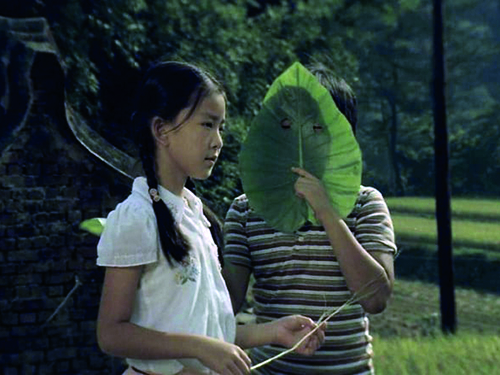
“Blending an episodic romance with children’s family problems and the pollution of the local river, Green, Green Grass compares favorably with Ozu’s lyrical comedies of the 1930s. Shooting The Green, Green Grass of Home Hou had enjoyed improvising scenes with children and other nonprofessionals. His plotting, rather loose to begin with, had become more open-ended across the trilogy: the young lovers don’t unite in conventional ways at the end of either Cheerful Wind (1981) or Green, Green Grass. The latter film also has an episodic structure and openness to local color that has led some to see it as a harbinger of the New Cinema.”
David Bordwell1
“In this third commercial film, The Green, Green Grass of Home, however, Hou would have a major breakthrough with the children who perform with ease and aplomb. The most notable moment is when a young boy gets upset at his father for killing his pet owl. The composition in this fifty-five-second shot is quite striking, using strong staging in depth, with the father in the foreground while the young boy moves diagonally in the distance, kicking vegetables and yelling in a convincing fit of anger. These child performances got Hou noticed among critics for the first time. Hou says that he found it easy to direct children. He would never tell them when they made a mistake, but would always pretend that something was wrong with the lights, or that some crew member was at fault. (The crew members, in turn, all understood what Hou was after and would feign guilt.) The result was usually that the child actor would be even better on the second or third take. The most important development was not the notoriety, however, but a new modus operandi Hou has refined to the present day: improvisation. Hou would only tell these children the situation and would otherwise let them improvise the actual lines of dialogue, something he would never do with stars such as Kenny B or Feng Feifei. This method of directing, initially reserved only for children in The Green, Green Grass of Home, is today Hou’s method with every actor: Hou usually provides situations, moods and a sense of the atmosphere – but no precise lines of dialogue or strict blocking instructions.”
James Udden2
“Hou has always been coy about the Ozu influence, and it's true that the conventional pastoral image of the train delivering urbanites to the country is as much John Ford as Ozu. And perhaps Ford is the more apt comparison: both directors have made masterful films about their respective country's history and myths, with the passage from tradition to modernity marked as a train journey from country to city; both have a particular interest in communities and families, and in the mundane details of everyday life, especially eating and drinking; both are obsessed with memory and recollection, especially as conveyed through oral or folk traditions; stylistically, both have an unmatched talent for deep and ensemble staging and favour long shots and low light levels; both are at once sentimental and detached, at home in the world and, as immigrants, alien to it. Even the broad comedy of Hou's early films is close to Ford's folksy humour: I like to think of the mischievous ‘Three Musketeers’ in The Green, Green Grass of Home as the descendants of the pals in The Iron Horse (1924). Also, Hou, like Ford, is a master bullshitter, who likes to give the impression that those teeming, minutely balanced ensemble shots came together by sheer fortuity. He also likes to pretend that he is not a cinephile.”
Tom Paulus3
- 1David Bordwell, “Hou, or Constraints,” Figures Traced in Light: On Cinematic Staging (Los Angeles: University of California Press, 2005): 193, 203.
- 2James Udden, No Man an Island: The Cinema of Hou Hsiao-hsien (Hong Kong: Hong Kong University Press, 2009).
- 3Tom Paulus, “All the Youthful Days: Hou at the Beginning,” DVD Booklet essay in CINEMATEK's ‘Hou Hsiao-hsien: Early Works’ Box set, 2016.

